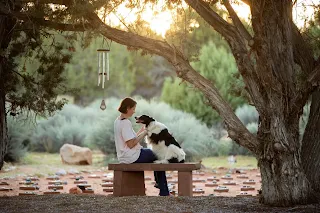Owning a senior dog comes with its own set of challenges and rewards. As our loyal companions age, their needs change, and so must our care for them. This article explores the journey of caring for a senior dog, highlighting the challenges and providing guidance to navigate this special time.
As a pet parent of two elderly dogs, I can tell you truthfully that it becomes expensive, but the rewards you receive cannot be measured. My oldest, Austen, was in good health up until he turned 14. Once the got that old, he started exhibiting signs of heart problems (he was coughing all the time, especially at night).
The vet checked him out and told me that all the valves in his heart were leaking, so he went on heart medications with routine ultrasounds every 6-8 months to see if changes were needed. He lived another 2 1/2 years on his medications and he was not impaired in any way.
He absolutely loved going for walks and riding in the car. When it became time for him to leave me, he simply stopped eating and stayed in bed all the time until he made me know that he was ready to leave.
His sister, Diva, is one year behind him. She has had some health issues in the past 4 or 5 years, and I almost lost her to pancreatitis. She spent 7 days in ICU at the Emergency Vets and finally got better.
She was fine until about a year ago when she developed an ulcer on her right cornea that refused to heal despite all the eye drops I put in it. She finally had to have that eye removed, but she recovered well and was her normal self in no time.
Unfortunately, this year, she developed an ulcer on her only other eye that would not get better despite eye drops every 2 hours around the clock. She finally had to lose the remaining eye also.
So now I have this sweet, old girl that is blind and hard of hearing. We are dealing with it and she is slowly learning her way around. Yesterday, I saw her running around in the back yard! That made me very happy. So it seems she is adapting.
I tell you all of this to show that older dogs are just like people and will become more fragile as they age. If you take on a pet, that pet becomes part of the family and you will do whatever it takes to help them.
I always recommend that when you get a pet dog or cat, you also should get some type of health insurance for them. Yes, you will pay premiums over the course of their lives and may not ever have to use the policy, but when they get older, you will get back just about all you every paid in to that insurance.

If you don't want to do that, or you can't afford to add another monthly fee to the bills, I then would recommend you apply for a CareCredit account to use for health emergencies for your pet. You really do have to be prepared from the first day of getting your pet because they live short lives compared to us and we have to take very good care of them.
Recognizing the Signs of Aging
As dogs age, they undergo both physical and behavioral changes. It's crucial to recognize these signs early to adjust their care accordingly. Physical changes may include graying fur, decreased mobility, and more pronounced health issues. Behaviorally, senior dogs might show signs of confusion, altered sleep patterns, and decreased interaction.
Health Challenges
One of the most significant challenges of having a senior dog is managing their health issues. Joint problems, such as arthritis, can severely impact their mobility. Sensory decline, including hearing and vision loss, requires adjustments in how we communicate with and care for them. Chronic conditions like heart disease, kidney issues, or diabetes become more prevalent and necessitate regular veterinary care and possibly medication.
Diet and Nutrition
A senior dog's diet may need to be adjusted to accommodate their changing health needs. Lower-calorie diets can help manage weight, while certain supplements might address joint health or cognitive function. It's essential to consult with a veterinarian to tailor a diet plan that supports their overall health.
Exercise and Mobility
Maintaining an appropriate level of exercise is vital for senior dogs. While they may not have the same energy levels, gentle walks and play can help keep them mobile and manage weight. Mobility aids, such as ramps or stairs, can help them navigate their environment more easily.
Mental Health and Enrichment
Cognitive dysfunction syndrome, similar to dementia in humans, can affect older dogs. Providing mental stimulation through toys, puzzles, and short training sessions can help keep their minds active. Regular interaction and affection also play a crucial role in maintaining their mental health.
Veterinary Care
Regular veterinary visits become increasingly important for senior dogs. These check-ups can help catch and manage health issues early. Managing medications for chronic conditions is also a key aspect of their care.
Comfort and Accessibility
Making your home more accessible and comfortable for a senior dog can significantly improve their quality of life. This might include softer bedding, ramps, and keeping essentials like food and water within easy reach.
End-of-Life Care
Discussing end-of-life care is a challenging but necessary part of owning a senior dog. Palliative care options, understanding when they are in pain, and making the difficult decision about euthanasia are aspects that need to be considered with compassion and care.
The Emotional Bond
The bond between owners and their senior dogs often deepens. Recognizing and preparing for the eventual goodbye is an emotional process, and it's important to cherish every moment with them.
Support and Resources
Finding support through communities or online forums can be incredibly helpful. Many resources are available to help owners provide the best care for their senior dogs.
Caring for a senior dog is a journey filled with challenges, but it's also an opportunity to show deep love and compassion. By understanding their needs and making adjustments to their care, we can ensure their golden years are comfortable and filled with joy.





.jpg)


.jpg)








.jpg)























.jpg)






